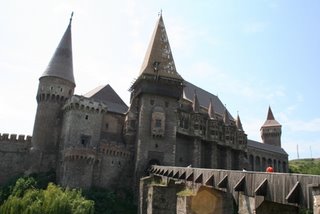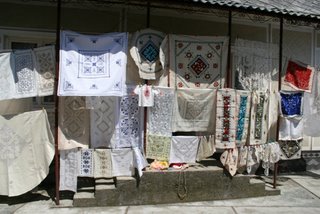 Driving through the amazing Transylvanian mountains.
Driving through the amazing Transylvanian mountains. A little village's idea of tourist souvenirs!
A little village's idea of tourist souvenirs! 
This is the little Devin church. It was constructed out of a Roman soldiers tomb, and is filled with gorgeous paintings and reused Roman building materials.
 The Dacians were the first real civilization in Romania, during and before the time of the Romans. The Romans eventually conquered them and took over their jewelry-making technology and gold mines. This is in a view of the hilltop Dacian city which was one of the guard cities of the main capital, Sarmezegetusa. They had stone circles there but it was a 7 hour walk to the capital, so we didn't go.
The Dacians were the first real civilization in Romania, during and before the time of the Romans. The Romans eventually conquered them and took over their jewelry-making technology and gold mines. This is in a view of the hilltop Dacian city which was one of the guard cities of the main capital, Sarmezegetusa. They had stone circles there but it was a 7 hour walk to the capital, so we didn't go. This is of Corvin Castle, one of the most picturesque castles I've ever seen that's in the middle of a city.
This is of Corvin Castle, one of the most picturesque castles I've ever seen that's in the middle of a city.
This is the inside courtyard of the castle. Count how many different shapes of arches there are! It's an architecture study if ever I saw one.
 This is a Roman garrison site and frontier-post city in the north of Romania.
This is a Roman garrison site and frontier-post city in the north of Romania. This is the ampitheatre, which remarkably, despite not really having high walls, still produces an echo of good acoustics when standing in the center.
This is the ampitheatre, which remarkably, despite not really having high walls, still produces an echo of good acoustics when standing in the center. On our first day in the north, we drove through the charming Maramures area, which had this famous village with unique (and humorous) cemetary crosses. Each one was a cartoon with a short poem of the person, usually outlining troubles or vices! One particular one had a picture of a hit and run, for example!
On our first day in the north, we drove through the charming Maramures area, which had this famous village with unique (and humorous) cemetary crosses. Each one was a cartoon with a short poem of the person, usually outlining troubles or vices! One particular one had a picture of a hit and run, for example! This is the souvenir shop across the road from the church, which had beautiful embroidery, cross-stiching and lacy doilies, etc.
This is the souvenir shop across the road from the church, which had beautiful embroidery, cross-stiching and lacy doilies, etc. One reason to head to this part of Romania is for the picturesque wooden churches.
One reason to head to this part of Romania is for the picturesque wooden churches. Here is everyone standing outside one.
Here is everyone standing outside one.
This is a picture of the rooftops, with their amazing wooden tiles.

Here's the monastery that's been built there.
 The landscape surrounding the churches is beautiful rolling green countryside, with the typical haystack, often nicely in a row, but usually just a ramshackle pile of hay over the garden fence.
The landscape surrounding the churches is beautiful rolling green countryside, with the typical haystack, often nicely in a row, but usually just a ramshackle pile of hay over the garden fence. They make these haystacks like a tent, and it's similar to a stile that a horse jumps over. Then it's simply a matter of piling it on.
They make these haystacks like a tent, and it's similar to a stile that a horse jumps over. Then it's simply a matter of piling it on. This is one of the pot trees that the villagers use. This particular one is decorative, but others still use similar trees for their functional enamel pots.
This is one of the pot trees that the villagers use. This particular one is decorative, but others still use similar trees for their functional enamel pots.








1 comment:
I think my next vacation will be a graveyards tour. I love graveyards.
Post a Comment